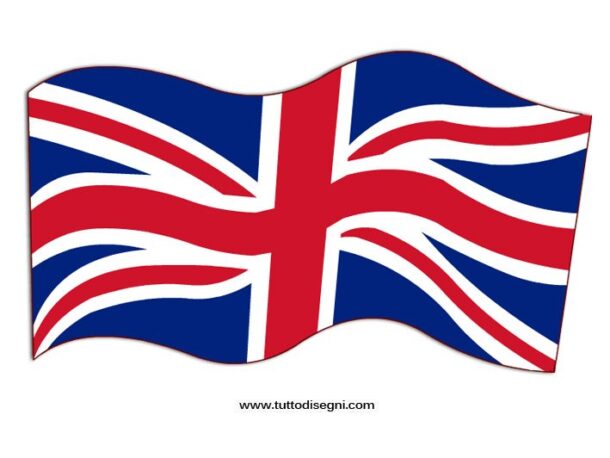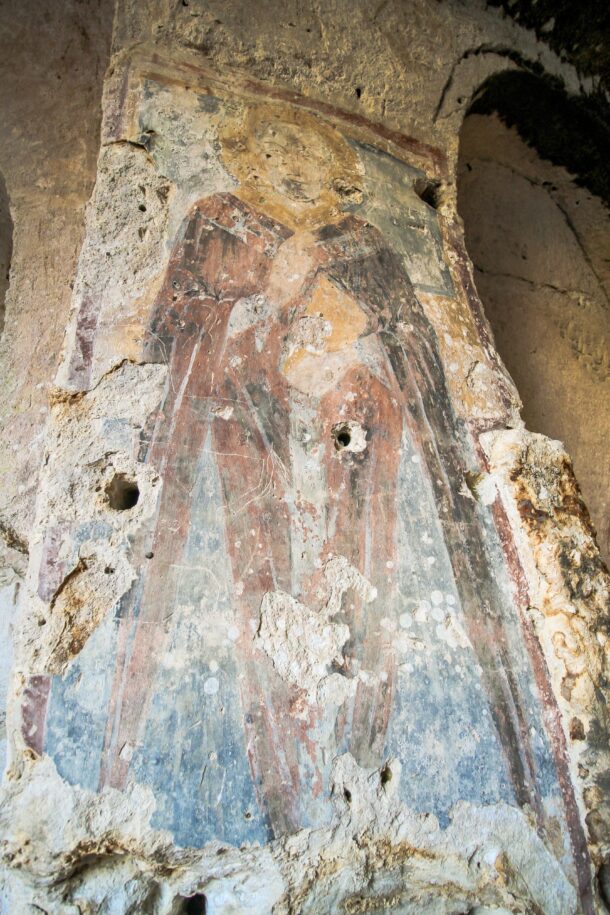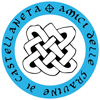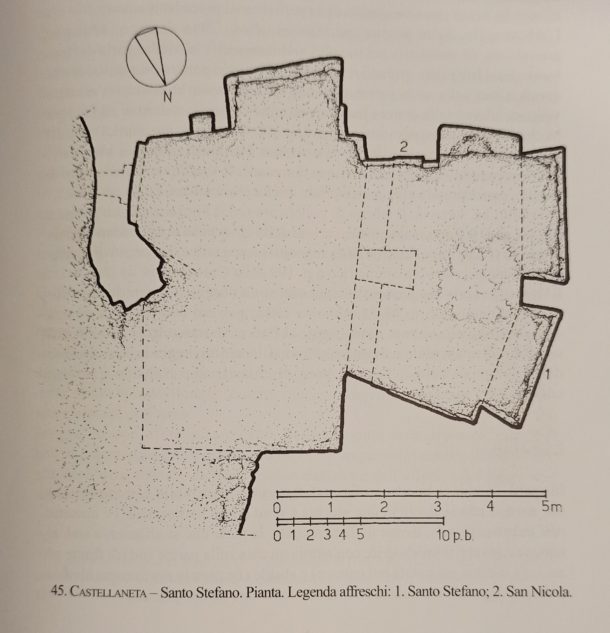Il complesso costituito dal villaggio e della chiesa di Santo Stefano è scavato a mezza costa sul fianco occidentale della gravina che porta il nome del Santo e si raggiunge per mezzo di una gradinata in discesa, immediatamete a sud troviamo la cripta.
CHIESA GROTTA S. STEFANO E S. NICOLA DI MIRA EPOCA X o XI secolo ARCHITETTURA
Esterno L’accesso a questo luogo di culto ha un profilo ampio, ma irregolare, dovuto a una frana della parete rocciosa. In alto, a sinistra, e’ ancora visibile un tratto, ad angolo retto, della cornice che delimitava l’ingresso. E’ affiancato da una scalinata intagliata nel tufo, molto usurata.
Interno Lo schema planimetrico ha forma pseudo-rettangolare, divisa in due parti da un pilastro quadrato di cui, però, resta solo il moncone superiore, affiancato da due archi gemelli, perfettamente semicircolari. La posizione del banco tufaceo, ha dato a questo luogo di culto un orientamento antiliturgico; l’abside, infatti, si trova subito a sinistra dell’ingresso e non sul fondo della navata. Questo assetto anomalo deriva dal fatto che l’officiante doveva assolutamente avere lo sguardo rivolto ad Oriente. La calotta absidale e’ illuminata da una piccola apertura rettangolare, alta e stretta, sotto la quale c’è un’altra apertura, originariamente di forma trapezoidale. Sulla parete sud ci sono due nicchiette trapezoidali, in asse tra loro, di diverse dimensioni. Sulla parete nord c’è una grande nicchia, ma solo parzialmente scavata.
 The complex consisting of the village and the church of Santo Stefano is dug halfway up the western side of the ravine that bears the name of the Saint and is reached by means of a descending staircase, immediately to the south we find the crypt.
The complex consisting of the village and the church of Santo Stefano is dug halfway up the western side of the ravine that bears the name of the Saint and is reached by means of a descending staircase, immediately to the south we find the crypt.
CHURCH GROTTA S. STEFANO AND S. NICOLA DI MIRA PERIOD 10th or 11th century ARCHITECTURE
Exterior The access to this place of worship has a wide but irregular profile, due to a landslide of the rock face. At the top, on the left, a section, at a right angle, of the frame that delimited the entrance is still visible. It is flanked by a staircase carved into the tuff, very worn.
Interior The planimetric scheme has a pseudo-rectangular shape, divided into two parts by a square pillar of which, however, only the upper stump remains, flanked by two twin arches, perfectly semicircular. The position of the tuff bank has given this place of worship an anti-liturgical orientation; the apse, in fact, is located immediately to the left of the entrance and not at the end of the nave. This anomalous arrangement derives from the fact that the celebrant absolutely had to have his gaze turned towards the East. The apse dome is illuminated by a small rectangular opening, tall and narrow, under which there is another opening, originally trapezoidal in shape. On the south wall there are two trapezoidal niches, aligned with each other, of different sizes. On the north wall there is a large niche, but only partially excavated.
Una delle Cripte più note e più importanti è quella detta di Santo Stefano. Si apre questa con un ampio svasamento del prospetto, a guisa d’ immenso fornice, al declivio occidentale e a mezza costa del fianco della gravina omonima.
 One of the most famous and important Crypts is that of Santo Stefano. This opens with a large flare of the facade, like an immense arch, on the western slope and halfway up the side of the ravine of the same name.
One of the most famous and important Crypts is that of Santo Stefano. This opens with a large flare of the facade, like an immense arch, on the western slope and halfway up the side of the ravine of the same name.
PITTURA Questo luogo di culto conserva miracolosamente due affreschi, tutto sommato in buone condizioni di conservazione.
All’interno della cripta troviamo alcune nicchie con affreschi del XI-XII secolo ancora parzialmente integri. Nella nicchia più a nord è raffigurato Santo Stefano ( fig. 1) , mentre l’affresco più a sud rappresenta San Nicola (fig. 2)
 PAINTING This place of worship miraculously preserves two frescoes, all in all in good condition.
PAINTING This place of worship miraculously preserves two frescoes, all in all in good condition.
Inside the crypt we find some niches with frescoes from the 11th-12th century still partially intact. In the northernmost niche is depicted Saint Stephen (fig. 1), while the southernmost fresco represents Saint Nicholas (fig. 2)

( fig. 1 ) affresco risalente al XII secolo raffigurante Santo Stefano ( fig. 1 ) fresco dating back to the 12th century depicting Saint Stephen

(fig.2 ) affresco del XII secolo raffigurante San Nicola (fig.2) 12th century fresco depicting Saint Nicholas






